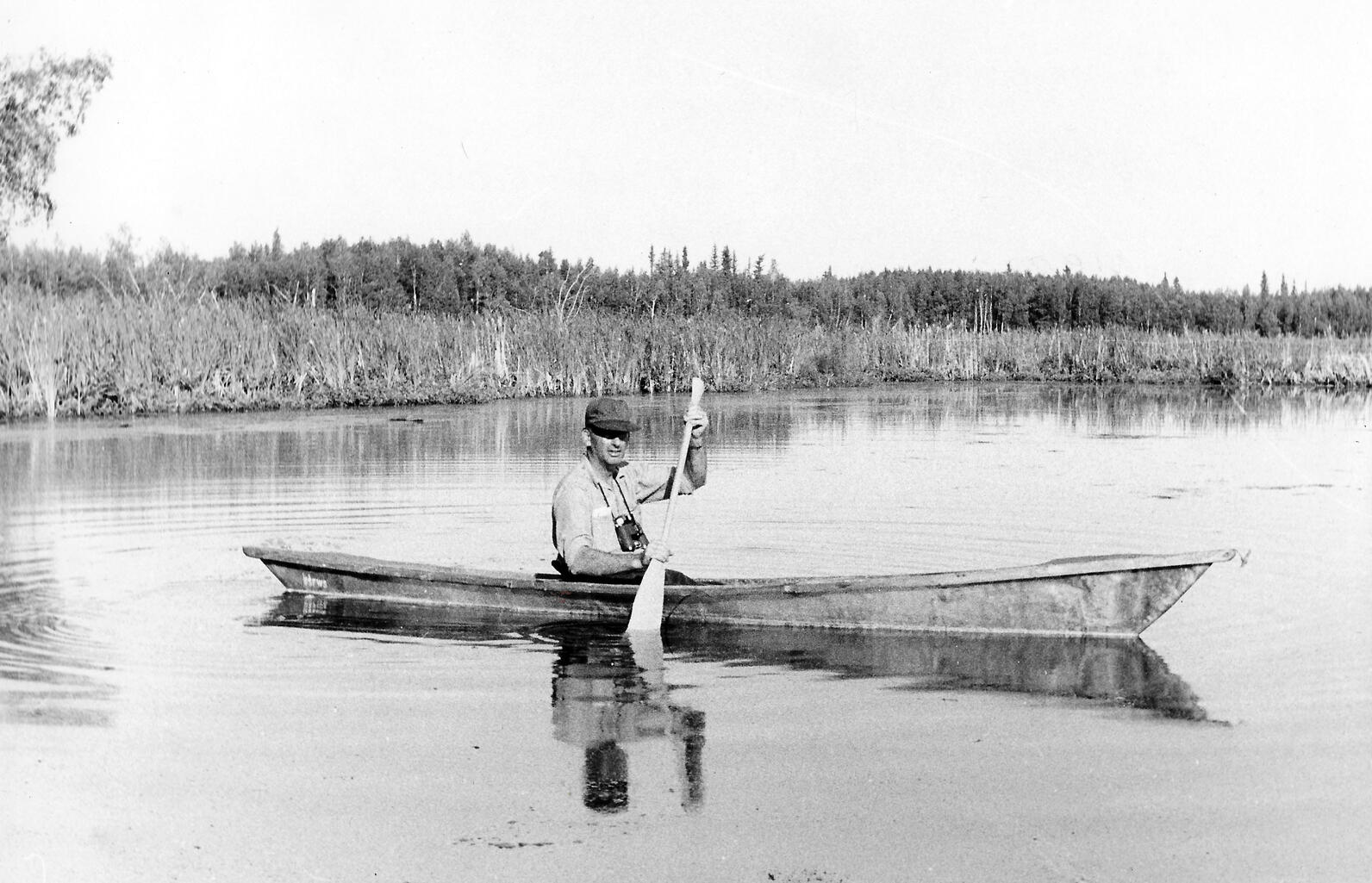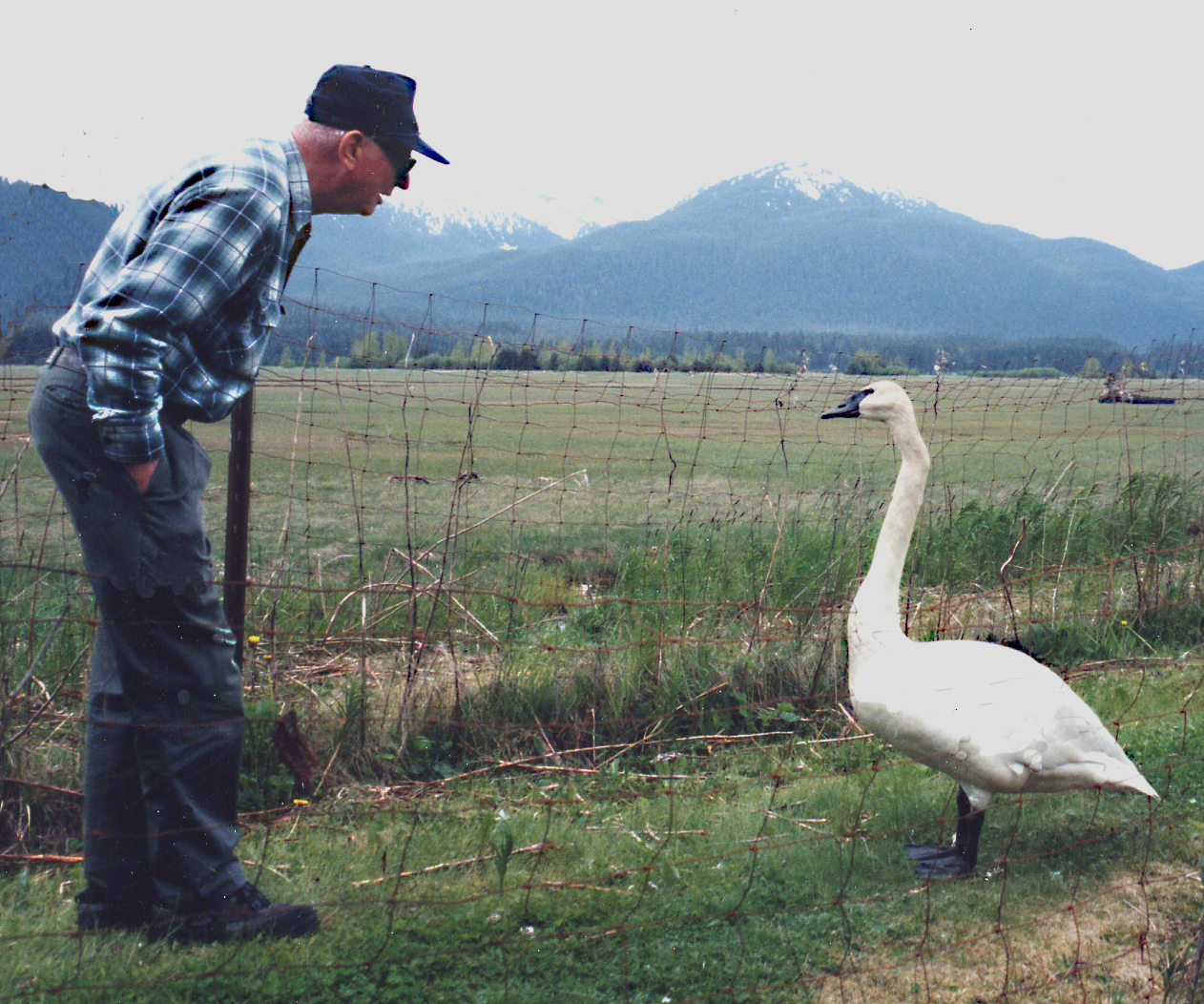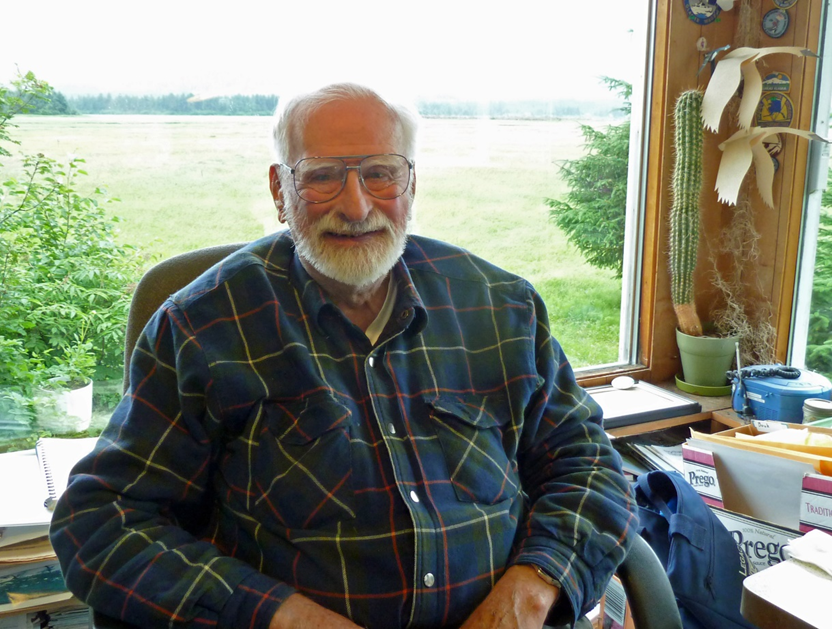A small estate tucked away at Sunny Point on the edge of Taashuyee-Chookan.aani, or the Mendenhall Wetlands, might seem like any other Juneau homestead. But for decades, this spread has been home to James and Mary Lou King and their three children (and to some degree their 10 grandchildren and seven great-grandchildren).
James Gore "Jim" King VI was a famed Alaska waterfowl biologist who died on March 31, 2024, at 96. He moved to Alaska from New England in 1949 after one year at Harvard University to enroll at the University of Alaska Fairbanks. King and Mary Lou (a well-known advocate in Southeast Alaska who authored “90 Plus Short Walks Around Juneau,” among many other accomplishments) met in Alaska and married on April 8, 1961. They lived in Fairbanks, Fort Yukon, and Bethel before settling in Juneau.
King was first a game warden for the U.S. Fish and Wildlife Service (USFWS) based out of Fairbanks. He then spent two years in Bethel as the first Refuge Manager for the Clarence Rhodes National Wildlife Refuge, the precursor to the Yukon Delta National Wildlife Refuge, in the early 1960s. In 1964, he moved to Juneau to become Supervisor of Waterfowl Investigations—a program that ultimately morphed into the Alaska Region of Migratory Bird Management. He retired from the USFWS in 1983 but was certainly not grounded. He continued working with birds and in his community into his 80s.
This impressive array of conservation and bird-focused credentials and accomplishments earned him the moniker of Alaskan Conservation Hero, and we’re about to tell you why.

Breaking It Down By Region
Overall—often literally—King’s work was in identifying important bird habitat statewide. This resulted in the “establishment of nine national wildlife refuges and protecting over an additional 55 million acres of waterfowl habitat” according to The Trumpeter Swan Society newsletter “Trumpetings.”
In Southwest Alaska, King worked to protect bird-important places like Cape Newenham and Cape Peirce. This started in the early 60s while he was living in Bethel. In 1966, he completed a report, accompanied by photos taken by Mary Lou, that proposed a 250,000-acre refuge to protect the drainage into Chagvan and Nanvak bays. A total of 44 bird species are covered in the report. Capes Newenham and Peirce are now part of the Togiak National Wildlife Refuge since both areas “provide nesting habitat for some of the largest mainland-nesting seabird colonies in Alaska and continue to provide important habitat for a variety of shorebirds, waterfowl, and other wildlife.”
Here is King describing the areas in "Attending Alaska's Birds: A Wildlife Pilot’s Story," his 2008-published memoir:
"The images of birds at Cape Newenham and nearby Cape Peirce never left a little place in the cells of my brain. I can see them today, over 40 years later. I considered a Cape Newenham report as unfinished business after settling in Juneau. The biggest challenge was to describe something for which words in the English language had never been invented. Words like blizzard or swarm could not describe sitting on the water under such a cloud of airborne life. Teeming, or mass aggregation could not really evoke the scene as one looked down on a rocky island of several acres, where it would seem no other bird could land unless one left, even though the air above seemed saturated with birds that belonged there. Avalanche, cascade, or cataract didn't really evoke the image of the flood of birds diving off the cliffs as the airplane went by."
In Alaska’s northeast, King was known for his duck roundups—22,000 ducks banded in three years—in the Yukon Flats region. This work and his waterfowl surveys of Yukon Flats were instrumental in Secretary of Interior Stewart Udall's decision to oppose a proposal to build Rampart Dam on the Yukon River, a project that would have resulted in a Lake Erie-size flooded area. In 1970, King submitted a proposal for the Yukon Flats National Wildlife Refuge, detailing the wide range of birds as well as “the furbearers that had enticed the Hudson's Bay Company to their most far-flung post,” he wrote in “Attending Alaska’s Birds” in Chap. 11. “I thought a wildlife refuge on Yukon Flats should include a fitting tribute to the fur trade and the animals that made it all possible.”
In the Arctic, King’s surveys on the North Slope identified and promoted the Teshekpuk Lake region as a critical molting ground for geese from Canada, Russia, the Yukon Delta, and the Arctic Coastal Plain. This discovery helped create a special conservation status for this region within the National Petroleum Reserve-Alaska. (To learn more about the NPR-A and Teshekpuk Lake, check out “What’s So Special About Alaska’s Special Areas?”)
In Southeast Alaska, King was an original member of the City and Borough of Juneau’s Parks & Recreation Advisory Committee. He was also involved in the Alaska Conservation Society, Pacific Seabird Group (responsible for helping to get several seabird species on the endangered list), The Trumpeter Swan Society, Juneau-area Alaska State Parks (responsible for helping to get several popular parks created), Territorial Sportsmen, Alaska Democratic Party, American Bald Eagle Research Institute, and Exxon Valdez Oil Spill Settlement Public Advisory Group. And to an extent, he assisted the Juneau Audubon Society, Taku Conservation, and Trail Mix Inc.
The Kings also donated one acre of their land as a conservation easement to the Southeast Alaska Land Trust in 2002. This acreage is part of the Mendenhall Wetlands complex. It acts as a site for Tree Swallow Nest Boxes—a project overseen by Juneau Audubon Society’s Brenda Wright (a long-time friend of the King family) that compiles a long-term data set on the nest success of Tree Swallows.

King’s Work With Birds
Aside from being a wildlife pilot, King may be best known for his work with swans.
According to "Trumpetings" Vol. 34, No. 1, “In 1968, King designed and conducted the first range-wide census of Trumpeter Swans in Alaska in 1968 when the species was in peril across North America. His initial statewide Trumpeter Swan survey planted the benchmark that proceeded the species’ recovery … resulting spatial data has been used countless times to protect nesting habitats in Alaska.”
King recounted this work in his memoir as well: “The swans have led to great rewards in the form of personal education, family pleasure and contact with other swan fanciers. I do hope we have contributed in the 20th century in a way that will help the enormously larger human population of the 21st century want to make a place for a grand free-flying population of a few hundred thousand wild swans."
Then there was Koog, Tina, and many other swans that made themselves at home at the King homestead in Juneau. This period of King’s life is best documented in Chap. 12 of his memoir, “The Family Bird Farm, 1965-95.” (Please do not sleep on this reading recommendation.)
Jim’s focus was not limited to waterfowl alone. Jim developed an aerial plot-based survey method for measuring bald eagle densities through much of coastal Alaska that laid important population benchmarks for these amazing raptors. Additionally, Jim recognized the tremendous but vulnerable seabird resources in Alaska in the 1970s. He co-founded the Pacific Seabird Group (PSG) to increase the flow of knowledge of seabird ecology and inform decision-makers.
But really, King’s passion was Alaska’s birds—period—and no one says it better than King himself.
“Flying among Alaska's birds is what I did for over 50 years, logging more than 9,000 hours as a pilot or co-pilot,” reads the introduction to King’s memoir. “I focused on the birds, often at between 100 and 500 feet above ground, to try to determine: what kinds there were, how many, what they were doing, how they were faring, and what they might need from mankind.”

Words From Colleagues
In addition to being a husband, father, grandfather, and great-grandfather, King was a colleague, mentor, and friend to many. Here’s what a few folks have to say about their time knowing King:
“As a U.S. Fish and Wildlife Service Waterfowl Biologist working in Alaska, I have the pleasure to follow a path laid down decades ago by Jim King. The foundation of much of our monitoring program today is due to Jim’s discovery of key habitats throughout the entire life cycles of many waterfowl species. Through his innovative aerial surveys and his legendary banding efforts, Jim discovered and publicized the importance of Alaskan wetlands to breeding waterfowl that come from all North American Flyways and beyond. These efforts helped establish the boundaries of many National Wildlife Refuges and other protected lands in Alaska and headed off land-altering developments. Jim King’s conservation legacy is lasting and a benefit to all who benefit from healthy waterfowl populations today.”
—Julian Fischer, Supervisory Wildlife Biologist with the U.S. Fish and Wildlife Service
“Jim King’s influence on our knowledge about and conservation of waterfowl, in Alaska, and across North America, is well documented. But Jim was more than a waterfowl biologist but a true conservationist. In the face of intense clearcut logging taking place in Southeast Alaska, he was an integral part in the first aerial survey of nesting bald eagles there in 1967. He flew the survey with observer (and USFWS employee) Fred Robards to document nest sites so they could be protected from logging operations. This protection was integral in the Bald Eagle’s recovery from the eagle bounty years in Alaska and Jim went on to fly several subsequent eagle surveys in Southeast Alaska and Prince William Sound over the next 15 years. In my years with the USFWS, a highlight for me was Jim’s visits to our office in Juneau to check up on the status of Alaska’s birds, discuss issues in conservation that he continued to follow long after his federal retirement, and to tell a story or two about the early days in Alaska bird conservation.”
—Steve Lewis, Wildlife Biologist with the U.S. Fish and Wildlife Service
“Jim King was a visionary in collecting and analyzing fundamental population data on Alaska birds using aircraft to enumerate loons, waterfowl, marine birds, and bald eagles. Jim’s reports and published accounts of his bird surveys and leg-banding projects were vital in providing justification for the addition of vast acreages to the National Wildlife Refuge system through the Alaska National Interest Lands Conservation Act of 1980. His legacy will be lasting in many other ways too because he so generously helped legions of scientists, birding enthusiasts, conservationists, and the general public learn about the biology, behavior, and ecology of Alaska’s avifauna and their vulnerability to human perturbations.”
—Dirk V. Derksen, Supervisory Biologist (retired) with the U.S. Geological Survey, Alaska Science Center

Recognition
King’s many achievements did not go unnoticed. He won the National Wildlife Federation Alaska Conservationist of the Year in 1972, the U.S. Fish and Wildlife Service Superior Service Award in 1973, the U.S. Fish and Wildlife Service Safe Pilot Award in 1988, a University of Alaska Southeast Honorary Ph.D. Doctor of Science in 1989, the Pacific Seabird Group Life Time Achievement Award and the Trumpeter Swan Society Award in 1997, and the U.S. Department of Interior Distinguished Service Award in 2002.
In 2005, he and Mary Lou were awarded an Alaska Legislature Honor for receiving lifetime achievement recognitions from the Alaska Conservation Council. He also received an Alaska State Parks Recognition of 25 years of service in 2010, a U.S. Fish and Wildlife Service Recognition of 40 years of service in 2011, and the Alaska Recreation & Park Association Distinguished Service Award in 2012.
According to his obituary, written by his daughter Sara McDaniel, “The plaques, photos, and items received were displayed all over the house, along with art depicting his favorite places, items he collected on all his travels, thousands of books, and photos of his family.”
Final Thought
There’s much more to King’s story and life than we were able to highlight here. We highly recommend reading through "Attending Alaska's Birds: A Wildlife Pilot’s Story" if you’d like to learn more about his life and his invaluable contributions to Alaska’s birds and bird habitat.
Special thanks to Sara McDaniel, Julian Fischer, and Brenda Wright for providing a wealth of details on King’s personal and professional achievements.




